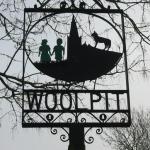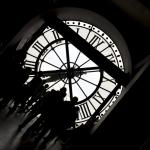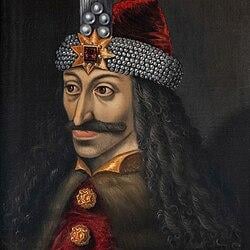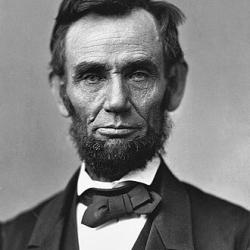Last Time on HOARATS
And Now we move on to the…
13th Century
13th century: c. 1200 – c. 1300 – Oxford Reference
Popes 177 – 193 reigned on the throne of St. Peter.
1 Saint Popes
2 Blessed Pope
14 Non – Sainted Popes
0 Anti – Popes
2 Interregnum
Most medieval wayfarers had never gone beyond the nearest market town, so every pilgrim could look forward to marvelous sights and strange encounters. Whether you journeyed to a national shrine like Canterbury, to an international destination like Santiago de Compostela in Spain, or to the most exotic goal of all, the Holy Land itself, you would have enough stories to tell on your return to fill what remained of your span of days.
I invite you on a pilgrimage, dear Reader. Come along with me (and many others) to places we have never seen before and to people we could otherwise never have expected to know. We are surely sundry folk, as Chaucer would have called us, and we shall meet sundry folk even more exotic than ourselves. “By aventure”—by happenstance—we have fallen into fellowship.
Thomas Cahill, Mysteries of the Middle Ages: And the Beginning of the Modern World (Hinges of History Book 5) (2010) . Knopf Doubleday Publishing Group.
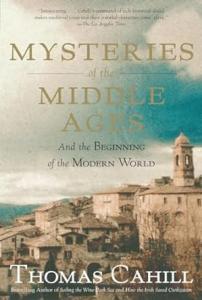
Adam of the Road is a novel by Elizabeth Janet Gray Vining. Vining won the Newbery Medal for excellence in American children’s literature in 1943 from the book. Set in thirteenth-century England, the book follows the adventures of a young boy, Adam. After losing his spaniel and minstrel father, Adam embarks on a series of escapades throughout medieval England. The book is illustrated by Robert Lawson.
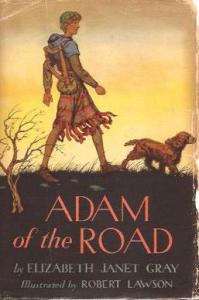
Crusade in Jeans (1973) is a children’s novel written by Thea Beckman. It contains a fictional account of the Children’s Crusade of 1212, as witnessed by Rudolf Hefting, a boy from the 20th century. The original Dutch title is Kruistocht in spijkerbroek. A film version was released in 2006.
1201–1205 – The Fourth Crusade is yet another attempt to recapture the Muslim-controlled city of Jerusalem.
April 12, 1204 – Sack of Constantinople: Crusaders enter Constantinople by storm and start pillaging the city as part of the Fourth Crusade. Forces of the Republic of Venice seize the antique statues that will become the horses of Saint Mark
1205 – The story of Parsifal and the Holy Grail becomes the subject of a courtly epic by Wolfram von Eschenbach. It is the first extant work in German to have as its subject the Holy Grail (in Wolfram’s interpretation a gemstone). It centers on the Arthurian hero Parzival (Percival in English) and his long quest for the Holy Grail following his initial failure to achieve it.
1206 – Temüjin assembles at a Kurultai, a council of Mongol chiefs, the tribes under his rule and is elected as their leader. He is given the title of “Genghis Khan” of the Mongol people – founding the Mongol Empire. Genghis takes immediate steps to underpin his military command, starting with a fundamental reordering of tribal loyalties. United under one nomadic nation, under one banner and one authority.
The first thing one learns when studying the world in the 13th century is the overwhelming importance of one long event, the Mongol conquest. As will be detailed, in 1200 the Mongol realm was confined to a remote part of the vast grasslands in East Asia. By 1300, Mongol rule was in place from Moscow to Korea, Turkey to the Pacific coast of China, southern Siberia to northern parts of Indo-China. This was the largest empire yet seen in world history. It remains the largest contiguous land empire, only being surpassed in total size by the British Empire at its height. This empire was not created in a peaceful manner.
Richard Bressler The Thirteenth Century: A World History (2018 ) McFarland & Company, Inc., Publishers.
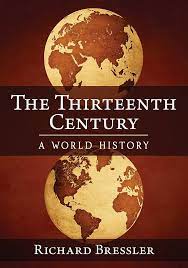
July 7, 1207 – St. Elizabeth of Hungary is born.
January 15, 1208 – Pierre de Castelnau is murdered by heretics supported by Raymond VI, count of Toulouse. He is held responsible and excommunicated by Pope Innocent III, leading to the Albigensian Crusade.
1209–1229 – The Albigensian Crusade is initiated by Pope Innocent III to eliminate Catharism in Languedoc, what is now southern France.
1210 – Pope # 176 Non-Saint Innocent III allows the formation of the mendicant order of Francis of Assisi, to begin the Order of Friars Minor.
1212 – The Children’s Crusade is organized. There are probably two separate movements of young people, both led by shepherd boys, neither of which embark for the Holy Land – but both of which suffer considerable hardship.
Learn More… The Children’s Crusade – YouTube
1212 – The Thomanerchor (English: St. Thomas Choir of Leipzig) is a boys’ choir in Leipzig, Germany is formed.
One of the oldest boy choirs in Germany singing Matthäuspassion (St Matthew Passion) by their own cantor from XVII Century – J.S. Bach. However now the choir is led by inimitable Georg-Christoph Biller. This is a very short sequence of originally almost 3 hours long musical masterpiece.
1212 – Saint Clare of Assisi leaves home to become a student of Saint Francis of Assisi. She later that same year founds the Order of Poor Ladies (Poor Clares)
September 14, 1214 – St. Albert of Jerusalem (1149 – 14 September 1214), dies. He contributed the Carmelite Rule of St. Albert to the newly-founded Carmelite Order.
1215 – Catholic Ecumenical Council #12: Fourth Lateran Council
This council defined transubstantiation, addressed papal primacy and clerical discipline.
June, 15 1215 – The Magna Carta the royal charter of rights is agreed to by King John of England at Runnymede, near Windsor.
December 22, 1216 – Pope # 177 Non- Saint Honorius III (July 18, 1216 – 18 March 18, 1227 -10 years, 243 days) officially approves the Order of Preachers (the Dominican Order), founded by St. Dominic, by the Papal bull Religiosam vitam.
1216 –Ballintubber Abbey is founded by King Cathal Crobhdearg Ua Conchobair of Connacht, in Ireland.
1218–1221 – The Fifth Crusade continues its mission to recapture Jerusalem.
1219 – St. Francis of Assisi goes to Egypt in an attempt to convert the sultan al-Kamil and put an end to the conflict of the Fifth Crusade.
1220 – Nearly 200 windows make Chartres cathedral the most magnificent display of early stained glass.
1228–1229 “Crusade” of Frederick II is launched when the Knights Templar and Knights Hospitaller deny him their support for the Crusade because of his excommunication by by Pope # 178 Gregory IX, (March 19, 1227 – 22 August 22, 1241 – 14 years, 156 days) for setting out for the Crusade before he has obtained absolution from his previous ex-communication in 1227.
1220 – A new shrine built at Canterbury Cathedral in England to house the remains of St Thomas Becket quickly becomes one of Europe’s major places of pilgrimage, and the destination of the fictional pilgrims in Geoffrey Chaucer‘s set of narrative poems The Canterbury Tales, written about 170 years later.
1221 – St. EOH marries Louis IV, Landgrave of Thuringia at 14.
1223 – Franciscan friars arrived, and the teenage Elizabeth not only learned about the ideals of Francis of Assisi, but started to live them. Louis was not upset by his wife’s charitable efforts, believing that the distribution of his wealth to the poor would bring eternal reward; he is venerated in Thuringia as a saint, though he was never canonized by the church.
c. 1225 – Francis of Assisi – Praise of God’s creation the oldest known Italian poetry is written.
Blessed are those who endure in peace
for by You, Most High, they shall be crowned.
Praised be You, my Lord, through our Sister Bodily Death,
from whom no living man can escape.
Woe to those who die in mortal sin.
Blessed are those who will find Your most holy will,
for the second death shall do them no harm.
Praise and bless my Lord, and give Him thanks
and serve Him with great humility.
September 11, 1227 – Louis, en route to join the Sixth Crusade, died of a fever in Otranto, Italy, just a few weeks before the birth of his and St. EOH’s daughter Gertrude. Upon hearing the news of her husband’s death, Elizabeth reportedly said, “He is dead. He is dead. It is to me as if the whole world died today.”
1229-1298 – The Golden Legend by Jacobus, de Voragine is written. It is translated by William Caxton (1422-1491).
1231 – In the Middle Ages, a judicial procedure that was used to combat heresy; in early modern times, a formal Roman Catholic judicial institution. Inquisito, a Latin term meaning investigation or inquest, was a legal procedure that involved the assemblage of evidence and the prosecution of a criminal trial. Use of the procedure against the heresies of the Cathari and Waldenses was approved by Pope Gregory IX in 1231. Inquisition summary | Britannica
April 13, 1231 – Pope Gregory IX issues Parens scientiarum. The bull assures the independence and self-governance of the University of Paris.
Anthony of Padua, OFM (August 15, 1195 – June 13,1231) dies. Noted by his contemporaries for his powerful preaching, expert knowledge of scripture, and undying love and devotion to the poor and the sick, he was one of the most quickly canonized saints in church history, being canonized less than a year after his death. He became a Doctor of the church in 1946.
The story of Anthony “preaching to the fish” originated in Rimini, where he had gone to preach. When heretics there treated him with contempt, Anthony was said to have gone to the shoreline, where he began to preach at the water’s edge until a great crowd of fish was seen gathered before him. The people of the town flocked to see this marvelous thing, after which Anthony charged them with the fact that the fish were more receptive to his message than the heretics of the church, at which point the people were moved to listen to his message.
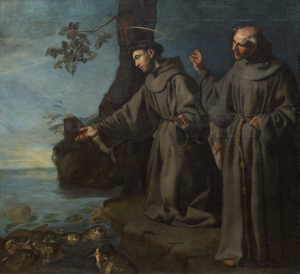
Saint Anthony Preaching to the Fishes, c. 1630
November 17, 1231 – St. Elizabeth of Hungry dies in Marburg at the age of twenty-four.
1233 – Pope Gregory IX sends Dominican friars to root out the remains of the Catharist heresy in France, thus launching the Inquisition.
May 24, 1235 – St. EOH is canonized by Pope Gregory IX.
I currently work at Saint Elizabeth Home named after EOH and have been there for over two years. Saint Elizabeth Home was rated #1 Nursing Home in Rhode Island in the Providence Journal Community’s Choice Awards. Our skilled nursing home located in East Greenwich offers short-term rehabilitation, long-term care and specialized memory care.
1235 – “Ce fut en mai“, or “Ce fu en mai“, (It happened in May) is a French trouvère song, written in the 13th century by Moniot d’Arras. Its lyrics, in Old French, describe how a man sees a knight and a maiden cavorting in a garden. He follows them, and tells them of his unrequited love; they comfort him, and he cries and commends them to God. The song is a pastourelle and chanson, and was originally accompanied by dancing and medieval instruments like the vielle.
June 1235 – Robert Grosseteste as Bishop of Lincoln. Upon his death, he was revered as a saint in England, but attempts to procure a formal canonisation failed. A. C. Crombie called him “the real founder of the tradition of scientific thought in medieval Oxford, and in some ways, of the modern English intellectual tradition”.
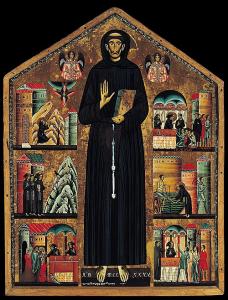
Bonaventura Berlinghieri, Saint Francis of Assisi, 1235
1240 – Albert of Stade joins the Franciscan order and begins his chronicle.
c. 1240–1250 – Roger Bacon – Summa Grammatica is published.
1242–1248 – Construction of Sainte Chapelle in Paris.
1245 – Catholic Ecumenical Council # 13: First Council of Lyons
It proclaimed the deposition of Emperor Frederick II and instituted a levy to support the Holy Land.
1248–1254 – First Crusade of King St. Louis IX of France.
July 16, 1251 – The feast day of Our Lady of Mount Carmel. Celebrated by the Carmelite Order–but doubted by modern historians–as the day when Saint Simon Stock had a vision of the Virgin Mary.
Learn More… The Feast of Our Lady of Mount Carmel – July 16th – YouTube
1259–1273- St. Dr. Thomas Aquinas’s Summa Theologica is written.
In 1939 –St. Thomas Aquinas and the Occult J. B. McAllister publishes St. Thomas Aquinas’s treaty on the Occult Workings of Nature. Aquinas: De operationibus occultis: English (isidore.co) St. Thomas Aquinas and the Occult, Part 2
1263 – St. Bonaventure – Life of St. Francis of Assisi is written.
May 16, 1265 – St. Simon Stock, OCarm dies.
1265 – The poet and creator of the Divine Comedy and his muse are born.
- approximate date – Dante Alighieri, Italian poet (d. 1321)
- approximate date – Beatrice Portinari, Dante Alighieri‘s beloved and guide through Heaven in The Divine Comedy (d. 1290)
BETWEEN THE BIRTH OF Dante in 1265 and the death of Galileo in 1642, something happened which would transform the entire culture of western civilization. Painting, sculpture and architecture would all visibly change in such a striking fashion that there could be no going back on what had taken place. Likewise, the thought and self-conception of western European humanity would take on a completely new aspect. Sciences would be born, or emerge in an entirely new guise. Part of this cultural transformation would be influenced by the rediscovery of the pre-Christian literature of Ancient Greece and Rome, but much of it would result from how the novelty of this earlier – essentially pagan – outlook came into conflict with, and was assimilated by, the society in which it was rediscovered.
Paul Strathern, The Florentines: From Dante to Galileo: The Transformation of Western Civilization (Italian Histories) (2021) . Pegasus Books
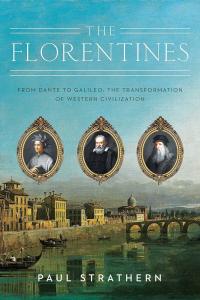
1268 – The first mention of a lens occurs in a manuscript by Roger Bacon, to be soon followed by the invention of spectacles.
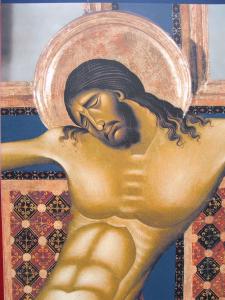
Cimabue’s Crucifix, Chiesa di san Domenico, Arezzo, 1265/1268
1269–1272 – Second Crusade of King St. Louis IX of France
1271 – The 17-year-old Marco Polo departs from Venice with his father and uncle Niccolò and Maffeo Polo, to set off for Asia – to meet the Mongolian emperor Kublai Khan (the grandson of Genghis Khan) – at his court in Beijing in China. They sail across the Mediterranean Sea and travel overland, crossing Armenia, Persia, and the Pamir Mountains.
Watch The Adventures of Marco Polo – YouTube
1274 – Catholic Ecumenical Council # 14 – Second Council of Lyons:
This council attempted reunion with the Eastern churches, defined teaching on purgatory, approved Franciscan and Dominican orders, a tithe to support crusades, and conclave procedures.
1274 –Bonvesin da la Riva, Italian poet, writes the didactic-allegoric poem Liber di Tre Scricciur (“Book of the Three Scriptures”). The text is in the Western Lombard language (similar to other Gallo-Italic languages). The poem is one of the first great literary works in Italy. It tells about Hell, the Passion of Jesus and Paradise; the plot later prefigures Dante Alighieri in his Divine Comedy (or La Divina Commedia).
March 7, 1274– St. Dr. Thomas Aquinas, dies. (b. 1225) He becomes a Doctor of the church in 1567. “Tantum ergo” is the incipit of the last two verses of Pange lingua, a Medieval Latin hymn generally attributed to St Thomas Aquinas c. 1264, but based by Aquinas upon various earlier fragments.
May 1, 1274 – In Florence, the 9-year-old Dante first sees the 8-year-old Beatrice, his lifelong muse. She appears later as one of his guides in the Divine Comedy, Paradiso and Purgatorio.
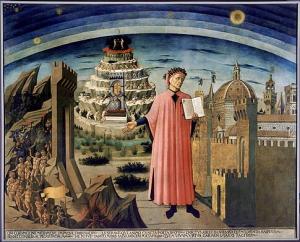
Dante shown holding a copy of the Divine Comedy, next to the entrance to Hell, the seven terraces of Mount Purgatory and the city of Florence, with the spheres of Heaven above, in Domenico di Michelino‘s 1465 fresco
July 15, 1274 – St. Dr. Bonaventure, dies. (b. 1221). He becomes a Dr of the church in 1588.
1275 – The 21-year-old Marco Polo together with his father and uncle, Niccolò and Maffeo Polo, arrives at Kublai Khan‘s opulent summer palace at Shangdu (or Xanadu), after a 4-year journey. They present the “Great Khan” sacred oil from Jerusalem and papal letters of Pope Gregory X. Kublai takes Marco into his royal court and appoints him as a ‘special envoy’ (possibly as a tax collector).
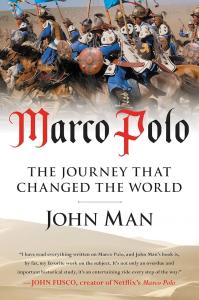
MARCO POLO IS PERHAPS THE WORLD’S MOST FAMOUS traveller, and his account of his journey from Venice to the court of Kublai Khan, ruler of the world’s greatest land empire, is the most famous travel book ever written. His Description of the World, or the Travels as it is usually entitled in English editions, is famous for three good reasons: because it was the first to open Central Asia and China to the West; because of its scale; and because of its essential truth.
But there’s another, hidden reason for its fame. It is a real-life fairy story. An ordinary boy is plucked from home by his father and taken to an unknown region, where he is presented to the richest and most powerful man in the world, who, marvellous to relate, becomes his mentor, and as a result he acquires
John Man, Marco Polo: The Journey that Changed the World (2014 ) HarperCollins
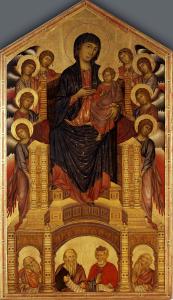
Cimabue Maestà, 1280–1285, Uffizi Gallery, Florence
Dr. St. Albertus Magnus OP (c. 1200 – November 15, 1280) dies. Also known as Saint Albert the Great, he was a German Dominican friar, philosopher, scientist, and bishop. Albert’s writings collected in 1899 went to thirty-eight volumes. These displayed his prolific habits and encyclopedic knowledge of topics such as logic, theology, botany, geography, astronomy, astrology, mineralogy, alchemy, zoology, physiology, phrenology, justice, law, friendship, and love. He digested, interpreted, and systematized the whole of Aristotle’s works, gleaned from the Latin translations and notes of the Arabian commentators, in accordance with Church doctrine. Most modern knowledge of Aristotle was preserved and presented by Albert. He became a doctor of the church in 1931. He was known during his lifetime as Doctor universalis and Doctor expertus.
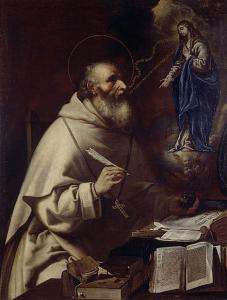
The Apparition of the Virgin to Saint Albert the Great
by Vicente Salvador Gomez
The iconography of the tympanum and archivolts of the late 13th-century portal of Strasbourg Cathedral was inspired by Albert’s writings. Albert is frequently mentioned by Dante, who made his doctrine of free will the basis of his ethical system. In his Divine Comedy, Dante places Albertus with his pupil Thomas Aquinas among the great lovers of wisdom (Spiriti Sapienti) in the Heaven of the Sun.
In Mary Shelley’s Frankenstein, the titular Frankenstein studies the works of Albertus Magnus.
1291 – Fall of Acre: The last Christian stronghold in the Latin East falls. When Acre fell, the Crusaders lost their last major stronghold of the Crusader Kingdom of Jerusalem.
December 24, 1294 – Pope #193 Non- Saint Boniface VIII (December 24, 1294 – October 11, 1303 – 8 years, 291 days) succeeds Pope # 192 St. Celestine V, after Celestine V abdicates the papacy on December 13, only five months after reluctantly accepting his surprise election on July 5, wishing to return to his life as an ascetic hermit.
1295 – Marco Polo returns to Venice after 24 years of travel in China. When the Polo’s arrive, Venice is engaged in a naval war with the rival city of Genoa. Marco joins the war and arms a galley equipped with a trebuchet
IN 1295 MARCO POLO, accompanied by his father and his uncle, arrived back in Venice having travelled ‘from the Polar Sea to Java, from Zanzibar to Japan’. According to the man to whom Polo would one day dictate the story of his travels: from the time when Our Lord formed Adam our first parent with His hands down to this day there has been no man, Christian or Pagan, Tartar or Indian, or of any race whatsoever, who has known or explored so many of the various parts of the world and of its great wonders as this same Messer Marco Polo.
Paul Strathern, The Venetians (2021 ) Pegasus Books
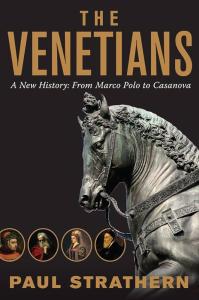
1298 – Marco Polo, in prison in Genoa, is persuaded by a fellow prisoner to narrate his adventures.
AS HE LANGUISHED in the Palazzo di San Giorgio, Marco encountered a prolific writer of Arthurian romances named Rustichello of Pisa, a favorite of King Edward I of England. The Genoese had captured the writer years earlier, on August 6, 1284, in the Battle of Meloria, while dealing a decisive blow to rival Pisa. Like the other detainees in the palazzo, Rustichello was looking for a means to cope with the enforced idleness, and Marco provided the necessary distraction. Eloquent and excitable on the subject of his travels, the Venetian talked volubly about his sojourn in the court of the most powerful ruler in the world, Kublai Khan.
Kublai Khan was, at the time, a half-real, half-legendary figure to most Europeans, who considered the Mongol Empire the most savage and dangerous realm on earth. Yet here, in Rustichello’s presence, was a man who had not only seen Kublai Khan but appeared to know him well, and who in his service had traveled from one end of Asia to the other, and beyond.
-Laurence Bergreen, Marco Polo (2007) Knopf Doubleday Publishing Group
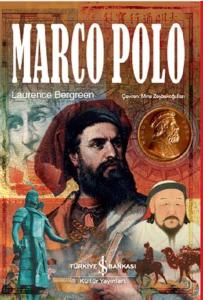
1298- 4 Saints are selected as Doctors of the Church.
Saint Ambrose of Milan proclaimed a Doctor of the Church
Saint Augustine of Hippo proclaimed a Doctor of the Church
Saint Gregory the Great proclaimed a Doctor of the Church
Saint Jerome proclaimed a Doctor of the Church
The term “doctor” originally derived from the Latin word docere, “to teach.” It designated anyone whose knowledge qualified him to teach, and therefore not necessarily one who would be skilled in caring for human health. But, as such, “doctors” were experts in promoting a certain kind of health—you might even say the most important kind: that health of soul and spirit which comes from knowing the truth.
“Doctors of the Church” are people who have seen the glory of Jesus Christ, full of grace and truth. In addition, by cooperating with God’s special graces and by employing as well as possible their unique intellectual and pedagogical gifts, they are persons who have succeeded in an outstanding way in communicating the truth they have contemplated in Jesus. As such they are eminent as teachers, which, as we have seen, corresponds precisely to the original meaning of the word “doctor.” Moreover, their teaching brings health to the human heart and soul.
Rev. Fr. Christopher Rengers O.F.M.Cap, Dr. Matthew E Bunson, The 35 Doctors of the Church: Revised Edition (2014)
Learn More… EWTN Live – 2022-04-06 – The Doctors of the Church – YouTube
14th Century
14th century: c. 1300 – c. 1400 – Oxford Reference
Popes 194 – 203 reigned on the throne of St. Peter.
0 Saint Popes
2 Blessed Pope
8 Non – Sainted Popes
3 Anti – Popes
1 Interregnum
1300– The Travels of Marco Polo is written.
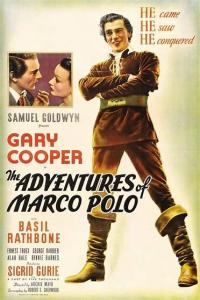
1305 –
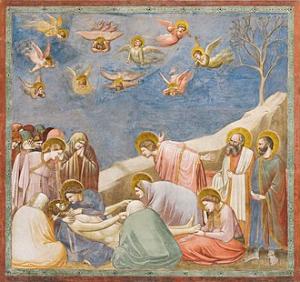
Lamentation by Giotto, 1305
1305– Sir William Wallace AKA Braveheart (c. 1270 – August 23, 1305) was a Scottish knight who became one of the main leaders during the First War of Scottish Independence. In August 1305, Wallace was captured in Robroyston, near Glasgow, and handed over to King Edward I of England, who had him hanged, drawn and quartered for high treason and crimes against English civilians.
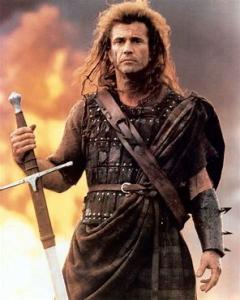
Timeline by Michael Crichton – A group of historians travels to 14th-century France.
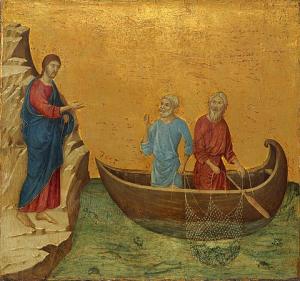
August 7, 1307 – St. Albert of Trapani OCarm ( c. 1240 – August 7, 1307) dies. He was an Italian Roman Catholic priest and a professed member of the Carmelites. He practiced great austerities upon himself to make himself poor in the spirit of Jesus Christ and went out preaching and evangelizing; he was known for working and maintaining a positive relationship with Jews as well as for his powers of healing. The saint was likewise attributed for the 1301 lifting of the siege in Messina that could have seen hundreds die from starvation had it not been for his intervention.
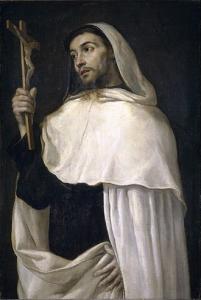
1309–1376: The Avignon Papacy occurs, in which seven successive popes reside in Avignon rather than Rome.
1310-May 12 – In France, 54 members of the Knights Templar are burned at the stake for heresy at Paris, on orders of King Philip IV (the Fair)
The Knights Templar – Jimmy Akin’s Mysterious World – YouTube
1311–1312- Catholic Ecumenical Council # 15: Council of Vienne
This Council disbanded the Knights Templar.
1316-Mondino de Luzzi’s major work, Anathomia corporis humani is considered the first example of a modern dissection manual and the first true anatomical text.
Saint Margaret of Città di Castello (1287 – 12 April 1320)
Beatified: 19 October 1609, Saint Peter’s Basilica, Papal States by Pope Paul V
Canonization:24 April 2021, Apostolic Palace, Vatican City by Pope Franci
Feast day: Pro-life movements, Disabled people, Blind people
Major shrine: Chiesa di San Domenico, Città di Castello, Perugia, Italy:
She was an Italian Roman Catholic and professed member of the Third Order of Saint Dominic. Margaret had disabilities and became known for her deep faith and holiness. Her parents abandoned her in a local church due to her disabilities and the town’s poor took her in and assumed care for her. Nuns later offered her a home at their convent but soon came to detest her presence and cast her out prompting the town’s poor to once again take her in and care for her. But she met with Dominican friars and was accepted as a secular member in their third order; she started a school for children to teach them in the faith and often took care of children while their parents were out at work.
Margaret’s holiness was apparent to all in her life that people lobbied for her to be buried in the local church which was an honor reserved for few – this was a clear demonstration people believed in her holiness.
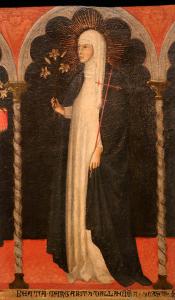
1320-The Divine Comedy (begun c. 1308 and completed in 1320) by Dante Alighieri (1265 – September 14, 1321)
Doomsday Book is a 1992 science fiction novel by American author Connie Willis. The novel won both the Hugo and Nebula Awards, and was shortlisted for other awards. The title of the book refers to the Domesday Book of 1086. Kivrin Engle, the main character, says that her recording is “a record of life in the Middle Ages, which is what William the Conqueror‘s survey turned out to be.”
The novel is the first in a series about Oxford time-traveling historians, which includes To Say Nothing of the Dog (1998) and Blackout/All Clear (2010). The story travels back to 1320.

1322: There are moments in music history, like all history, that stand as dividing lines. Once they happened, nothing could ever be the same.
One such moment was the writing of French theorist, poet, philosopher and composer Philippe de Vitry. In 1322, de Vitry wrote a treatise on music that forever changed the way music was written and expressed. It was entitled Ars Nova notandi, a new technique in writing music. Timeline 008: Ars Nova Versus Ars Antiqua | Vermont Public
1325: Recognized year of the founding of the Aztec capital Tenochtitlan on a small island in Lake Texcoco by the Mexica. It becomes Mexico City in 1521.
March 27, 1329 – Pope # 196 Non-Saint John XXII (August 7, 1316 – December 4, 1334 – 18 years, 119 days) with the bull In Agro Dominico accuses Meister Eckhart the German Catholic theologian, philosopher and mystic of heresy. He seems to have died before his verdict was received. Today he has acquired a status as a great mystic within contemporary popular spirituality, as well as considerable interest from scholars situating him within the medieval scholastic and philosophical tradition.
1330: John Wycliffe, (1328 – 31 December 1384) founder of the Lollard movement, is born in England.
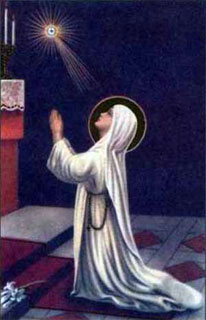
Blessed Imelda Lambertini (1322 – May 12, 1333)
Beatified 1826, Saint Peter’s Square, Vatican City by Pope Leo XII
Feast May 13
She had an intense love of God and wanted to receive the Eucharist at the early age of 5. The age limit for communion was 14. At age 9 she went to live with the Dominican nuns at Val di pietra, near Bologna.
According to Wikipedia…
On May 12, 1333, the day of the vigil of the Ascension, she knelt in prayer and the “Light of the Host” was reportedly witnessed above her head by the Sacristan, who then fetched the priest so he could see. After seeing this miracle, the priest felt compelled to admit her to receiving the Eucharist. Immediately after receiving it, Lambertini went back to her seat, and decided to stay after mass and pray. Later when a nun came to get Lambertini for supper, she found Lambertini still kneeling with a smile on her face. The nun called her name, but she did not stir, so she lightly tapped Imelda on the shoulder, at which Imelda collapsed to the floor dead. Her remains are kept in Bologna at the Church of San Sigismondo, beneath the wax effigy of her likeness. Learn More
1334 – Pope # 197 Non-Saint Benedict XII (December 20, 1334 – April 25, 1342 – 7 years, 126 days) institutes the Papal Cappella, which would eventually become the Capella Sistina or Sistine Chapel.
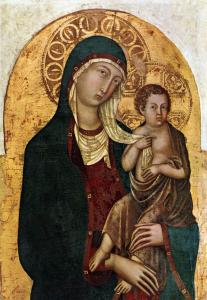
Madonna with Child, Niccolò di Segna, c.1336
July 4, 1336 – St. Elizabeth of Aragon (1271 –July 4, 1336), more commonly known as Elizabeth of Portugal dies. She was queen consort of Portugal. She is the great niece and namesake of St. Elizabeth of Hungary. When her husband King Denis of Portugal died she joined the Third Order of St. Francis, devoting the rest of her life to the poor and sick in obscurity. During the great famine in 1293, she donated flour from her cellars to the starving in Coimbra. She was also known for being modest in her dress and humble in conversation, for providing lodging for pilgrims, distributing small gifts, paying the dowries of poor girls, and educating the children of poor nobles. She was a benefactor of various hospitals (Coimbra, Santarém and Leiria) and of religious projects (such as the Trinity Convent in Lisbon, chapels in Leiria and Óbidos, and the cloister in Alcobaça).
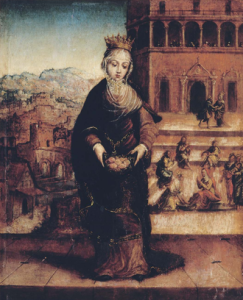
Painter Giotto di Bondone (c. 1267 – January 8, 1337) dies.
1337–1453: The Hundred Years’ War was a series of armed conflicts between the kingdoms of England and France during the Late Middle Ages.
Learn More: Why Was the Hundred Years War So Significant? Captivating History
1340: Gerard Groote (October 1340 – August 20, 1384) founder of the Brothers and Sisters of the Common Life, is born in the Netherlands.
1340: Excommunicated Franciscan friar William of Ockham advocates a philosophical idea that brings down arguments to their simplistic essentials. This is summed up in the phrase The simplest explanation is usually the best one which later became known as Ockham’s Razor.
1340 – Blessed John van Ruysbroeck (1293 or 1294 – December 2, 1381) writes his masterpiece, The Spiritual Espousals. The 36 surviving Dutch manuscripts, as well as translations into Latin and Middle High German, are evidence of the book’s popularity.
- The image of God is found essentially and personally in all mankind. Each possesses it whole, entire and undivided, and all together not more than one alone. In this way we are all one, intimately united in our eternal image, which is the image of God and the source in us of all our life.
- Quoted in Friends’ Intelligencer, Vol. 107 (1950), ed. 26-52, p. 657
- God is more interior to us than we are to ourselves.
His acting in us is nearer and more inward than our own actions.
God works in us from inside outwards;
creatures work on us from the outside.- John of Ruysbroeck Spiritual Espousals, complete works, Mechelen 1934, vol. 1, p. 148. English version New York 1953.
The High Crusade by Poul Anderson Sir Roger, Baron de Tourneville, captures a scouting craft for the Wersgorix Empire in 1345. His force and the village of Ansby are then taken to the Empire.
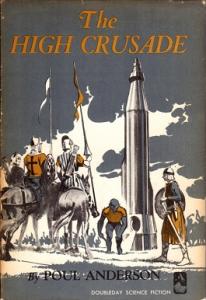
1347: St. Catherine of Siena (March 25, 1347 – April 29, 1380) mystic and Doctor of the Church, is born in Italy.
1347–1351: The Black Death kills 200 million people throughout Eurasia.
1353:Giovanni Boccaccio (June 16, 1313 – December 21, 1375) who was an Italian writer, poet, correspondent of Petrarch (July 20, 1304 – July 19, 1374) who was a scholar and poet of the early Italian Renaissance, and one of the earliest humanists., and an important Renaissance humanist. writes The Decameron which is a collection of short stories.
Learn More… Decameron by Giovanni Boccaccio Book Summary � – YouTube
“It’s only human to have compassion for the afflicted—a good thing for everyone to have, especially anyone who once needed comfort and found it in someone else; and speaking of such need, if anyone ever needed compassion or appreciated it or delighted in it, I’m the guy.” ‘
So begins Giovanni Boccaccio in the prologue to his revolutionary collection of streetwise stories, the Decameron, written midway through the fourteenth century.
The striking change in tone and sensibility between the Comedy and the Decameron, the two monumental masterpieces of early Italian literature, suggests a disruption in Italian life. The most noble figures of the High Middle Ages—Francis of Assisi, Thomas Aquinas, Dante Alighieri, Giotto di Bondone—had all lived and died between the late twelfth and the early fourteenth centuries. And in 1347 a terrible plague struck Europe, hitting Florence full force in late spring of 1348. Soon enough, there would be no going back to the supernal gentleness of Francis, the light-filled philosophical explorations of Aquinas, the grave vision of Dante, or the sweet playfulness of Giotto. Even the human compassion and fellow feeling that Boccaccio lauds in the very first sentence of his masterpiece, quoted at the outset of this section, will be cast aside.
Thomas Cahill, Heretics and Heroes: How Renaissance Artists and Reformation Priests Created Our World (Hinges of History Book 6) . (2013)Knopf Doubleday Publishing Group
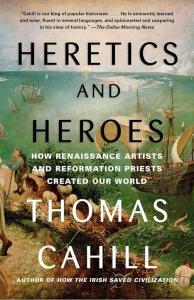
Bl. Urban V (September 28, 1362 – December 19, 1370) – 8 years, 82 days) becomes Pope #

Wikimedia Commons
1365 – – Guillaume de Machaut (c. 1300 – April 1377) composes Messe de Nostre Dame, the first complete polyphonic ordinary of the mass.
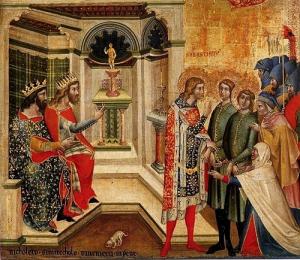
Niccolò Semitecolo, Two Christians before the Judges, Padua Cathedral, 1367
May 13, 1373 – English anchoress Dame Julian of Norwich (c. 1343 – after 1416) receives the sixteen Revelations of Divine Love. This is the earliest surviving English language works by a woman, although it is possible that some anonymous works may have had female authors. They are also the only surviving English language works by an anchoress.
“Truth sees God, and wisdom contemplates God, and from these two comes a third, a holy and wonderful delight in God, who is love.”
― Revelations of Divine Love
Learn More… Julian of Norwich and the English Mystics: A Lecture by Fr. Groeschel – YouTube
1374 – Gerard Groote (October 1340 – 20 August 1384) turned his family home in Deventer into a shelter for poor women and lived for several years as a guest of the Carthusian monastery. Groote was a Dutch Catholic deacon, who was a popular preacher and the founder of the Brethren of the Common Life. He was a key figure in the Devotio Moderna movement.
1377: Return of the papacy to Rome.
1377: Piers Plowman a Middle English allegorical narrative poem by William Langland (c. 1332 – c. 1386) contains the first known reference to a literary tradition of Robin Hood tales.
1378–1417: The Great Schism splits the papacy into separate political factions.
Learn More… A Century of Disarray: The Avignon Papacy and the Western Schism A Bit of History
1378: St. Dr. Catherine of Siena’s The Dialogue of Divine Providence. She becomes a Doctor of the Church in 1970.
Eternal God, eternal Trinity, you have made the blood of Christ so precious through his sharing in your divine nature. You are a mystery as deep as the sea; the more I search, the more I find, and the more I find the more I search for you. But I can never be satisfied; what I receive will ever leave me desiring more. When you fill my soul I have an even greater hunger, and I grow more famished for your light. I desire above all to see you, the true light, as you really are.
I have tasted and seen the depth of your mystery and the beauty of your creation with the light of my understanding. I have clothed myself with your likeness and have seen what I shall be. Eternal Father, you have given me a share in your power and the wisdom that Christ claims as his own, and your Holy Spirit has given me the desire to love you. You are my Creator, eternal Trinity, and I am your creature. You have made of me a new creation in the blood of your Son, and I know that you are moved with love at the beauty of your creation, for you have enlightened me.
1379 – Gerard Groote having received ordination as a deacon, he became a missionary preacher throughout the diocese of Utrecht. The success which followed his labours not only in the city of Utrecht, but also in Zwolle, Deventer, Kampen, Amsterdam, Haarlem, Gouda, Leiden, Delft, Zutphen and elsewhere, was immense; according to Thomas à Kempis the people left their business and their meals to hear his sermons, so that the churches could not hold the crowds that flocked together wherever he came.
c. 1380s: Agnolo Gaddi (c.1350–1396) works on painting The Coronation of the Virgin, The Finding of the True Cross and Madonna Enthroned with Saints and Angels
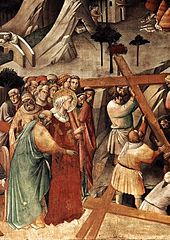
1380: John Wycliffe (c. 1328 – 31 December 1384) translates the Bible.
1386: Donatello (1386 -December 13, 1466) is born.
1386: The Salisbury Cathedral clock is a large iron-framed tower clock without a dial, in Salisbury Cathedral, England. It is a well-preserved example of the earliest type of mechanical clock, called verge and foliot clocks, and is said to be the oldest working clock in the world, although similar claims are made for other clocks. Previously in a bell-tower which was demolished in 1790, the clock was restored to working condition in 1956 and is on display in the North nave aisle of the cathedral, close to the West front.
1387 and 1400: The Canterbury Tales by Geoffrey Chaucer (1340s – October 25, 1400) is written.
Cosimo di Giovanni de’ Medici (September 27, 1389 – August 1, 1464) was an Italian banker and politician who established the Medici family as effective rulers of Florence during much of the Italian Renaissance.
1390: The Little Flowers of St. Francis is written.
“All the darkness in the world cannot extinguish the light of a single candle.”
“And St. Francis said: ‘My dear son, be patient, because the weaknesses of the body are given to us in this world by God for the salvation of the soul. So they are of great merit when they are borne patiently.”
La Harpe de Melodie is a musical composition by Jacob Senleches in the ars subtilior style.
HOARATS
To Understand
What I love and How I Write About History
Hit the Link Above.
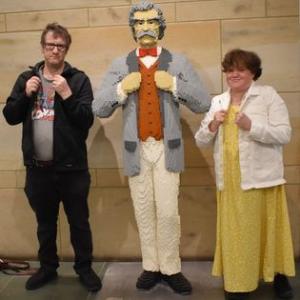
To understand about this particular series I’m writing about, please read
The Catholic Bard’s Guide To History Introduction
And to view a historical article click on


